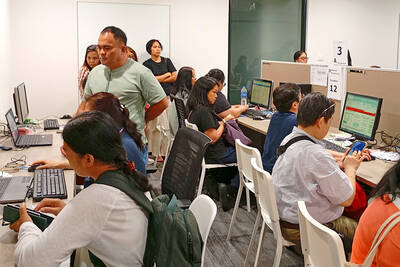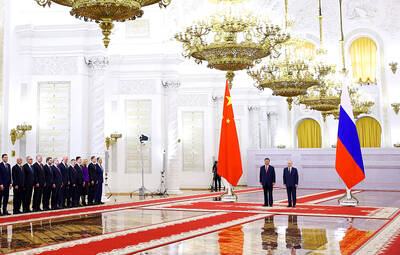Japan is planning a futuristic farm where robots do the lifting in an experimental project on land swamped by the March tsunami, the government said yesterday.
Under an agriculture ministry plan, unmanned tractors would work fields where pesticides would have been replaced by LEDs keeping rice, wheat, soybeans, fruit and vegetables safe until robots can put them in boxes.
Carbon dioxide produced by machinery working on the up to 250 hectare site would be channeled back to crops to boost their growth and reduce reliance on chemical fertilizers, the Nikkei newspaper said.
The agricultural ministry will begin on-site research later this year with a plan to spend around ¥4 billion (US$52 million) over the next six years, a ministry official said.
Land in Miyagi Prefecture, about 300km north of Tokyo, which was flooded by seawater on March 11, has been earmarked for the so-called “Dream Project.”
The tsunami, sparked by a magnitude 9 earthquake, inundated the country’s northeast, killing more than 19,000 people, according to the latest figures.
It also badly polluted the land, leaving it laden with salt and depositing oil on fields, with about 24,000 hectares of once-fertile farmland damaged by the tsunami, earthquake and fallout from the damaged Fukushima Dai-ichi nuclear power plant.
Meltdowns at reactors at the plant sent radiation into the air, the sea and food chain.
The atomic disaster and the ravaging of farmland were the latest blows to a struggling and ageing farm industry that is also facing the threat of renewed competition from abroad as Tokyo eyes a Pacific-wide free-trade pact.
High-tech companies such as Panasonic are to be invited to get involved in the project in a bid to give a much-needed boost to the beleaguered sector, the ministry spokesman said.
Among other companies expected to join the project are Fujitsu, Hitachi, Sharp, NEC, Yanmar, Ajinomoto and Ito-Yokado Co, according to the Nikkei.

A new online voting system aimed at boosting turnout among the Philippines’ millions of overseas workers ahead of Monday’s mid-term elections has been marked by confusion and fears of disenfranchisement. Thousands of overseas Filipino workers have already cast their ballots in the race dominated by a bitter feud between President Ferdinand Marcos Jr and his impeached vice president, Sara Duterte. While official turnout figures are not yet publicly available, data from the Philippine Commission on Elections (COMELEC) showed that at least 134,000 of the 1.22 million registered overseas voters have signed up for the new online system, which opened on April 13. However,

EUROPEAN FUTURE? Albanian Prime Minister Edi Rama says only he could secure EU membership, but challenges remain in dealing with corruption and a brain drain Albanian Prime Minister Edi Rama seeks to win an unprecedented fourth term, pledging to finally take the country into the EU and turn it into a hot tourist destination with some help from the Trump family. The artist-turned-politician has been pitching Albania as a trendy coastal destination, which has helped to drive up tourism arrivals to a record 11 million last year. US President Donald Trump’s son-in-law, Jared Kushner, also joined in the rush, pledging to invest US$1.4 billion to turn a largely deserted island into a luxurious getaway. Rama is expected to win another term after yesterday’s vote. The vote would

ALLIES: Calling Putin his ‘old friend,’ Xi said Beijing stood alongside Russia ‘in the face of the international counter-current of unilateralism and hegemonic bullying’ Chinese President Xi Jinping (習近平) yesterday was in Moscow for a state visit ahead of the Kremlin’s grand Victory Day celebrations, as Ukraine accused Russia’s army of launching air strikes just hours into a supposed truce. More than 20 foreign leaders were in Russia to attend a vast military parade today marking 80 years since the defeat of Nazi Germany in World War II, taking place three years into Russia’s offensive in Ukraine. Putin ordered troops into Ukraine in February 2022 and has marshaled the memory of Soviet victory against Nazi Germany to justify his campaign and rally society behind the offensive,

Myanmar’s junta chief met Chinese President Xi Jinping (習近平) for the first time since seizing power, state media reported yesterday, the highest-level meeting with a key ally for the internationally sanctioned military leader. Senior General Min Aung Hlaing led a military coup in 2021, overthrowing Myanmar’s brief experiment with democracy and plunging the nation into civil war. In the four years since, his armed forces have battled dozens of ethnic armed groups and rebel militias — some with close links to China — opposed to its rule. The conflict has seen Min Aung Hlaing draw condemnation from rights groups and pursued by the